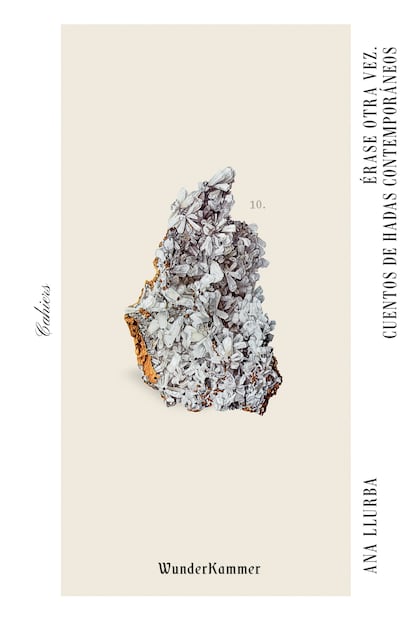Illustration for 'The Bloody Chamber', by Angela Carter, a collection in which she rewrote 10 fairy tales by Charles Perrault.
Over the past 200 or 300 years, Angela Carter (Eastbourne, UK, 1940-1992) used to say, fairy tales and folk tales - the tales of Mother Goose, that is, of the old wives, the gossip; their vulgarization is for her related to the fact that, clearly, they came from female voices, because, as Virginia Woolf believed, "anonymous" was always synonymous with "woman" - they have been compiled as an end in itself, " and they have been kept as a treasure for a wide range of reasons that go from the curiosity of the antiquarian to the ideology ”.
Carter noted, for example, how the brothers Grimm, Jacob and Wilhelm, philologists, antiquarians, and medievalists, "set out to establish a unitary culture for the German people" through their rewriting.
And at the same time, how in the 19th century the scholar JF Campbell traveled to the Scottish Highlands to “transcribe and thus preserve” the ancestral histories of the Gaelic language before English “swept them away”.
And also, of course, in what way they have inevitably permeated everything we see and read today, indirectly.
From Dickens' novels, he said, to
Dynasty
.
The British writer was a passionate folklorist who spent a good part of her life studying the folk tale and ended up shaping it, giving it her
In a way, one that had to do with not running away from danger — the world out there is wild, let's accept it and enjoy it — but with embracing it, with being carried away by desire, and the irrational, to its own compilation. He did so by mixing an infinity of traditions and giving rise to two volumes - compiled by Impedimenta into one in Spain:
Fairy Tales
(2016) - that majestically, very freely and darkly re-founded the genre.
Contaminated by the totemic and powerful spirit of Carter, Ana Llurba (Córdoba, Argentina, 40 years old) observes, from the vantage point of the present, in what way they continue today that “portable” imaginary, as Carter said, that anyone carries around “ as part of an invisible baggage ”, how the present narrative continues to be invaded, in some cases brilliantly and very explicitly, with revisited and reformulated fairy tales, a“ revisionism ”that coincides with the fourth wave of feminism but does not it only has to do with her, as she tells in the micro-essay
Once upon another time. Contemporary fairy tales
(Wunderkammer) “It is a constructive revisionism, a seedbed that triggers stimuli, which shows that these archetypes continue to speak but no longer say the same thing, crossed as they are by feminism, identity politics and the talent of, above all, female writers that they have proposed to turn them around ”, exposes the also writer, author of the book of stories
Family Constellations
(Aristas Martínez), among other volumes.
The process has been going on since the 1970s, as a reaction to the domestication of the popular story by the Disney factory.
Although not only for that, of course.
The writer Robert Coover, one of the leading representatives of American postmodernism, has dedicated his life to destroying every last myth he has come across so that nothing remains of them, with the intention of starting from scratch — he does in
El hurgón magico
and
Zarzarrosa
, where he imagines a sleeping beauty raped by the prince, and even in his
Pinocchio in Venice
, transforming himself, the writer, into a malted wooden doll.
Margaret Atwood, whose fiction was feminist before feminism, too.
Moshfegh, the sleeping beauty
It is not only that his first books of poetry deformed the archetypes of fairy tales, it is that his fiction returns to them again and again. "What is produced when you deform a fairy tale is that you move the scheme with which you look at the world," says Llurba, who analyzes works by Helen Oyeyemi, Kelly Link, Carmen Maria Machado, and even Ottessa Moshfegh, because, for the writer,
My year of rest and relaxation
is a kind of sleeping beauty —the protagonist, young, pretty, rich, decides to inflate herself on barbiturates to sleep for a year, and escape what is expected of her because she deeply abhors it— “no explicit ”. "It's her way of escaping being Carrie Bradshaw," she says.
Llurba attends, above all, to the new forms that old stories are adopting, even in the cinema, in order to "glimpse new horizons and new, more inclusive and, hopefully, more emancipating mythologies". Although, of course, it does a little tour about who has told those stories before and with what intention - how the woman's curiosity was constantly punished - but also the deformations that they have suffered from the beginning - how, for example, the original versions were "Polished" to present them to children in the nineteenth century.
"When the concept of childhood arises, fairy tales cease to be for adults, because in the time of Charles Perrault they were, they were entertainment at the court of Versailles, for the elite of the time", analyzes Llurba, who believes that, above all, female narrators - she also mentions Kristen Roupenian, Shirley Jackson, Cristina Fernández Cuba, Dubravka Ugresic and the poet Anne Sexton - use them for precisely the opposite of what they were created for: to end the expectations that are supposed to be women.
A still from Cinderella, a Disney animated film.
This is the case in
The Lure
, by Agnieszka Smoczynska, a film about a pair of mermaid sisters who are not angelic at all, and who do what they do, no matter how much the world tries to exploit them - in a hostess club - is to devour human hearts . Or in the way in which the characters that
Helen Oyeyemi's
Mr. Fox
creates, the amateur writer, like Bluebeard, to murder women - in his case, fictional - rebel against him and his obsession with mistreating women. But Llurba insists. Fairy tales, one might say, are mirrors that reflect the time when they were "recounted."
“Fairy tales have been building and rebuilding for centuries.
What I have tried is to spread my passion for current reconstruction, a passion that Angela Carter awakened in me ”, she says.
Passion that cannot help being there, from the beginning, in almost any life as a writer, because aren't they still fairy tales that they read first of all?
The trend, in any case, is a fact.
Next week Rebecca Solnit, the author of
Men explain things to me
, plans to add another title to this increasingly long list, a
liberated Cinderella
(Lumen) in which the protagonist dares to say enough.
You can follow BABELIA on
and
, or sign up here to receive
our weekly newsletter
.








